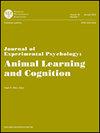人类几何学习中的遮挡与遮蔽。
IF 1.3
4区 心理学
Journal of Experimental Psychology-Animal Learning and Cognition
Pub Date : 2011-01-01
DOI:10.1037/a0020715
引用次数: 39
摘要
在一个基于计算机的二维搜索任务中,人类参与者被要求通过使用屏幕上可用的几何信息来学习目标的位置。当目标位置由两个显著性不同的形状定义时,更显著的形状掩盖了基于不显著形状的学习,而不是相反。此外,当一个形状被预训练为目标位置的信号时,学习另一个形状的几何线索被阻止。这些结果表明,基于几何的空间学习受联想原则支配,并支持不调用几何线索特殊地位的学习模型(例如,Miller & Shettleworth, 2007)。本文章由计算机程序翻译,如有差异,请以英文原文为准。
Blocking and overshadowing in human geometry learning.
In a two-dimensional computer-based search task, human participants were required to learn the location of a goal by using the geometric information available on the screen. When the goal location was defined by two shapes that differed in salience, the more salient shape overshadowed learning based on the less salient shape but not the other way round. Furthermore, when one shape was pretrained as a signal for the location of the goal, learning about the geometric cues of the other shape was blocked. These results suggest that spatial learning based on geometry is ruled by associative principles and support learning models that do not invoke a special status for geometric cues (e.g., Miller & Shettleworth, 2007).
求助全文
通过发布文献求助,成功后即可免费获取论文全文。
去求助
来源期刊
自引率
23.10%
发文量
0
审稿时长
>12 weeks
期刊介绍:
The Journal of Experimental Psychology: Animal Learning and Cognition publishes experimental and theoretical studies concerning all aspects of animal behavior processes.

 求助内容:
求助内容: 应助结果提醒方式:
应助结果提醒方式:


